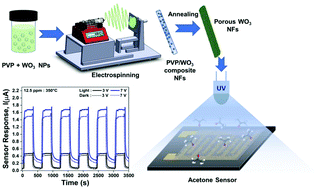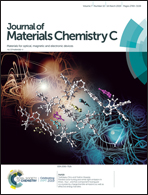Template based sintering of WO3 nanoparticles into porous tungsten oxide nanofibers for acetone sensing applications†
Abstract
Porous WO3 nanofibers have been synthesized by electrospinning polyvinylpyrrolidone (PVP) nanofibers embedded with semiconducting WO3 nanoparticles followed by annealing in air. PVP serves as a template in sintering of WO3 nanoparticles into nanofibrous morphology. Scanning electron microscopy (SEM) and transmission electron microscopy (TEM) characterizations have revealed a highly porous structure of WO3 nanofibers with diameters in the range of 800–1200 nm. Fourier transform infrared spectroscopy (FTIR) confirms complete removal of the polymer from the porous WO3 NFs after annealing. Amperometry based sensing performance of porous WO3 nanofibers is evaluated toward low concentrations (1.8–12.5 ppm) of acetone and further improved via light excitation (365 nm UV) and applied bias voltage (3–7 V). The applied bias voltage has a significant effect on sensor characteristics with a remarkably enhanced response at a higher bias voltage. A maximum response (Igas–Iair) of 1.79 μA is obtained at 7 V bias voltage toward 12.5 ppm acetone at 350 °C under UV irradiation. The porous WO3 nanofibers are able to detect 700 ppb of acetone with 3 V bias voltage using photo-activation with a response/recovery time of 33 s/42 s and excellent repeatability. The experimental results confirm the potential usage of the developed sensor based on electrospun porous WO3 nanofibers for acetone sensing applications.



 Please wait while we load your content...
Please wait while we load your content...